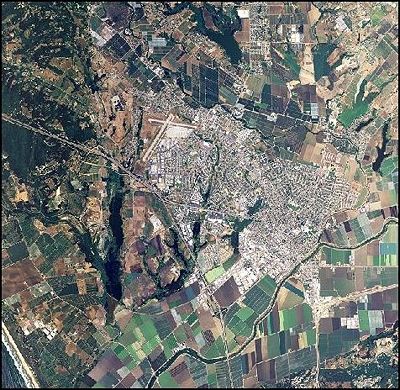Difference between revisions of "Urban stormwater management in the City of Watsonville"
(→Storm Water Management Plan) |
(→Summary) |
||
| Line 1: | Line 1: | ||
[[Image:watsonville_CA.jpg|400px|thumb]] | [[Image:watsonville_CA.jpg|400px|thumb]] | ||
==Summary== | ==Summary== | ||
| − | The City Of Watsonville's storm drain system directs storm water runoff through underground pipes that eventually | + | The City Of Watsonville's storm drain system directs storm water runoff through a network of underground pipes that eventually discharges into the Monterey Bay. This system includes 2000 storm drain inlets, 50 miles of pipeline, and 15 storm water pumps located along Corralitos Creek and the Pajaro River, which is currently listed as an impaired waterbody in the [[The 303d list of Impaired Waterbodies in the Monterey Bay Region|303 d list]]. The system was originally designed to control flood events.<ref> [http://cityofwatsonville.org/public-works-utilities/sewer-storm-drains Sewer/Storm Drains] </ref> The untreated storm water runoff drains directly into the ocean. |
| − | + | ||
==Regulatory Background== | ==Regulatory Background== | ||
Revision as of 14:59, 9 April 2013
Contents
Summary
The City Of Watsonville's storm drain system directs storm water runoff through a network of underground pipes that eventually discharges into the Monterey Bay. This system includes 2000 storm drain inlets, 50 miles of pipeline, and 15 storm water pumps located along Corralitos Creek and the Pajaro River, which is currently listed as an impaired waterbody in the 303 d list. The system was originally designed to control flood events.[1] The untreated storm water runoff drains directly into the ocean.
Regulatory Background
Many federal, state and local laws and policies have been implemented and enforced over the last few decades to reduce pollutants and contaminants being discharged into the Pajaro River, and the Watsonville Slough Complex.
Federal Regulations
See Urban stormwater regulations applicable to central coast region
Local Regulations
- Total Maximum Daily Load (TMDL) designations for Watsonville Pajaro River Nutrients TMDL
- TMDL designations for Watsonville Pajaro River Sediment TMDL
Management Strategies
The City of Watsonville follows Low Impact Development Best Management Practices that are outlined in the Design Guide,[2] which is an interim guide where the Watsonville designates a common hydromodification control standard with the Central Coast Regional Water Quality Control Board. The Design Guidance replaces the City of Watsonville’s Storm Water Land Development Standards.
Storm Water Management Plan
Watsonville submits an annual review of their Storm Water Management Plan's (SWMP) effectiveness, BMPs effectiveness and improvement opportunities to achieve the Maximum Extent Practicable (MEP) that are required under Phase II permit requirements.
Watsonville's Annual Reports:
Timeline
- 1997 Current Industrial Activities Storm Water General Permit
- 1999 Phase II of Section 402 of the Clean Water Act requires cities under 100,000 to implement SWMPs
- 2009 Storm Water Management Plan approved.
- 2010 City of Watsonville Urban Water Management Plan [1]
- 2011 Water Quality Control Plan for the Central Coastal Basin
Resources at Stake
A large percent of the population relies on the continued health and vitality of the agricultural industry for their income and livelihood. Storm water problems are a continuous threat to that economic sector due to past scares with E.coli contaminated lettuce in the region.[3] Also, the Watsonville Slough system is comprised of Harkins, Gallighan, Hanson, Struve, and Watsonville Sloughs and drains an area of approximately 50 km2 (13,000 acres).[4] This area contains significant coastal habitats including, salt marsh, brackish and fresh water marsh and the diversity of habitats within this coastal area makes the Watsonville Slough a valuable resource for both coastal plant communities as well as fish and migratory birds.
- Salsipuedes Creek Capacity Enhancement & Restoration Project: City and County staff are partnering with the US Army Corps of Engineers to receive early feedback with regard to permitting the project. Corps staff are in the process of securing permits for a bench excavation project along the creek. The process requires preparation of 70% complete design plans for the project and a hydraulic bank stability assessment, to be completed by Northwest Hydraulic Consultants, Inc. (NHC)[5]
Stakeholders
- Division of Public Works
- Central Coast Regional Water Quality Control Board
- City of Watsonville
- The City of Watsonville Resource Conservation Program
- Monterey Bay National Marine Sanctuary
- Community Foundation of Santa Cruz County
- Resource Conservation District of Santa CRuz County
- Watsonville Wetlands Watch
- Action Pajaro Valley
- Save Our Shores
- Ecology Action
References
- ↑ Sewer/Storm Drains
- ↑ Low Impact Development Best Management Practices - Design Guide
- ↑ Flynn, Dan. E. coli-Contaminated Lettuce Came from a California LGMA Grower. 2013 Jan 15. www.foodsafetynews.com
- ↑ Non-Point Source Program - CCA NPS Watershed Assessment for Watsonville Slough
- ↑ Northwest Hydraulic Consultants, Inc
Links
- Urban stormwater management in the Monterey Bay region
- Urban stormwater management in the City of Pacific Grove
- Urban stormwater management in the City of Scotts Valley
- Urban stormwater management in the City of Santa Cruz
- Urban stormwater management in the City of Capitola
- Urban stormwater management in Santa Cruz County
- City of Watsonville
- Watsonville Public Library
- Central Coast Watershed Studies
- Watsonville Water Quality Reports
Disclaimer
This page may contain student work completed as part of assigned coursework. It may not be accurate. It does not necessary reflect the opinion or policy of CSUMB, its staff, or students.
